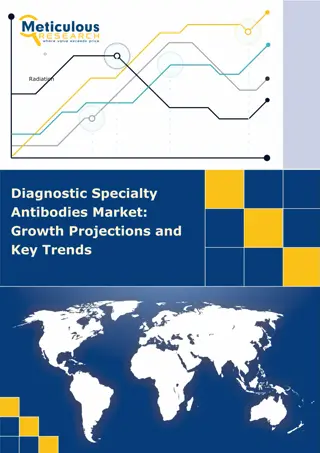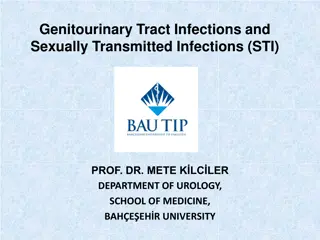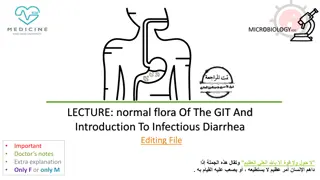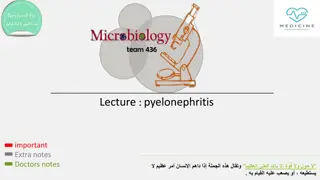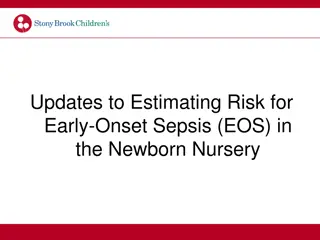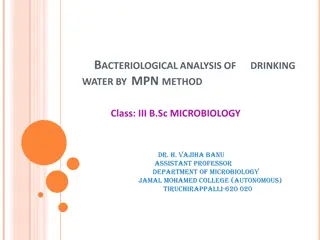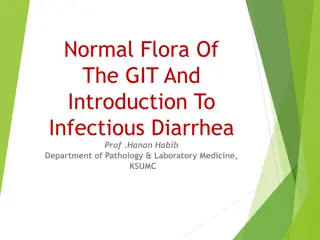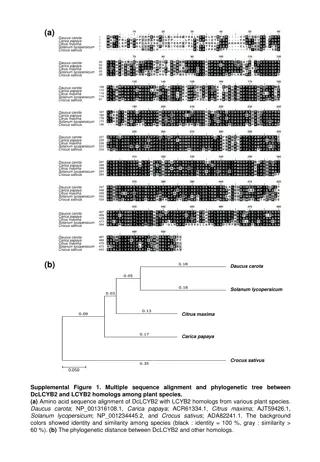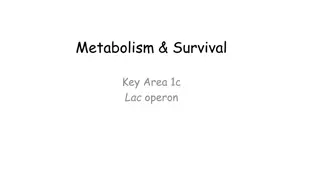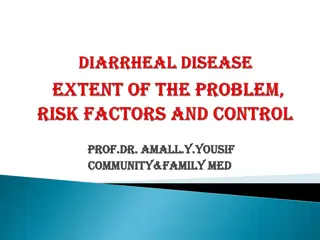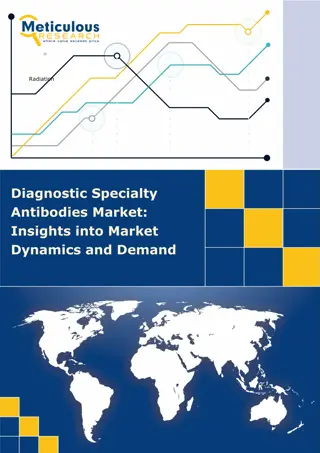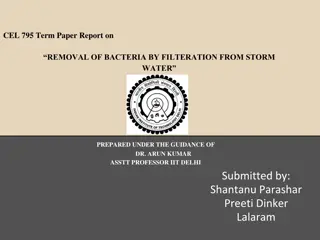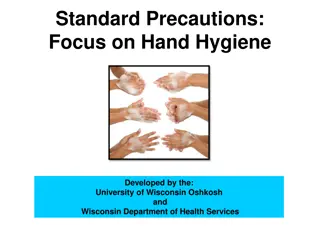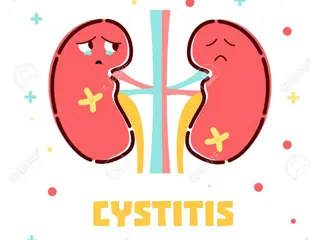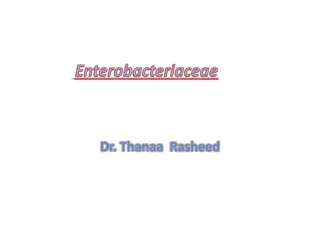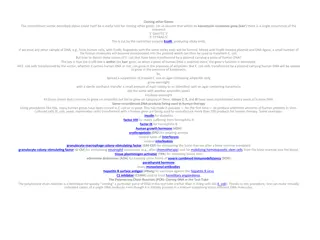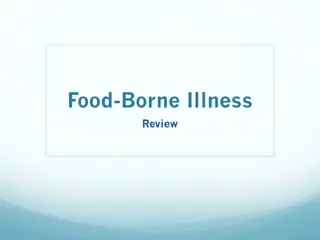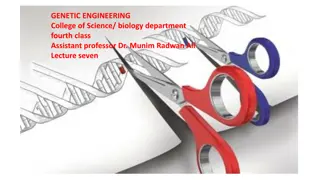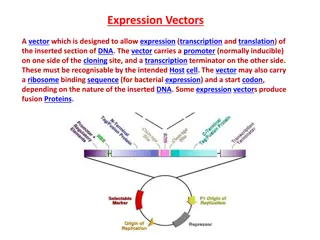Understanding Antibiotic Use in UTI Management: A Critical Review
Antibiotic use in urinary tract infections (UTIs) is crucial, but concerns exist due to rising resistance. E. coli, common in UTIs, can lead to resistant blood stream infections. Proper diagnosis and treatment are essential to combat antibiotic resistance and ensure patient recovery.
2 views • 44 slides
Diagnostic Specialty Antibodies Market is expected to grow at a CAGR of 4.6% fro
Diagnostic Specialty Antibodies Market by Type (Primary, Secondary), Clonality (Monoclonal, Polyclonal), Technique (WB, Rapid Test, IHC, IP), Conjugate, and Application (Dengue, Malaria, Hepatitis, HIV, E. coli , Tuberculosis, Pneumonia, Cancer)- For
0 views • 6 slides
Exploring Predictable Biodesign in Synthetic Biology
This content delves into the world of predictable biodesign and genetic composition in the context of synthetic biology. It highlights activities focusing on genetic device assembly, molecular techniques, and engineering principles to better understand and manipulate living systems. Through engaging
0 views • 36 slides
Overview of Genitourinary Tract Infections and STIs by Prof. Dr. Mete Kılcıler
Genitourinary Tract Infections and Sexually Transmitted Infections (STIs) are common conditions affecting both men and women. This article, presented by Prof. Dr. Mete Kılcıler from the Department of Urology at Bahçeşehir University School of Medicine, delves into the various aspects of UTIs, in
2 views • 47 slides
Neonatal Diseases
Neonatal and postnatal diseases in livestock, with a focus on perinatal, neonatal, and postnatal stages. It covers common classifications, causes, and risk factors associated with these diseases, particularly focusing on neonatal diarrhea (Calf Scour). The content delves into noninfectious and infec
0 views • 33 slides
Understanding Normal Flora of the Gastrointestinal Tract & Infectious Diarrhea
Normal flora in the gastrointestinal tract play a crucial role in maintaining health, but can also cause disease in certain conditions. This lecture covers the common flora in the GIT, their role in diseases, various types of acute diarrheal illnesses, epidemiology, and management of bacterial agent
1 views • 26 slides
Introduction to Phage DNA Integration in Bacterial Cells
Phage DNA can be introduced into bacterial cells through two methods: transfection and in vitro packaging. Transfection involves mixing purified phage DNA with competent E. coli cells, inducing DNA uptake via heat shock. In vitro packaging utilizes proteins coded by the phage genome, which can be pr
1 views • 13 slides
Understanding Pyelonephritis: Key Insights and Management
Pyelonephritis is a serious bacterial infection of the kidneys, leading to renal damage and potentially life-threatening complications. This condition has different etiologies, including ascending bacterial infection and hematogenous spread, with Escherichia coli being the most common causative orga
1 views • 22 slides
Understanding Water-borne Diseases and Pathogens
Drinking contaminated water can lead to water-borne diseases, causing millions of deaths annually, especially in developing countries. Potable water is essential for health and development, as water-related diseases arise from inadequate water quality and poor sanitation practices. Various pathogens
1 views • 28 slides
Understanding Early-Onset Sepsis (EOS) Risk Factors and Management in Newborns
Neonatal Early-Onset Sepsis (EOS) is a rare but life-threatening condition primarily caused by Group B Streptococcus (GBS) or Escherichia coli. Recognizing risk factors such as maternal age, intrapartum fever, GBS colonization, and certain neonatal characteristics is crucial for timely evaluation an
0 views • 26 slides
Bacteriological Analysis of Drinking Water by MPN Method in Microbiology Class III
This study focuses on the bacteriological analysis of drinking water using the Most Probable Number (MPN) method in a microbiology class. The MPN method involves enumerating and identifying bacteria in drinking water samples through a series of tests including presumptive, confirmed, and completed t
0 views • 13 slides
Understanding the Normal Microbial Flora of the Human Body
The normal microbial flora, also known as the indigenous microbiota, inhabit various areas of the human body such as the gastrointestinal tract, respiratory tract, genitourinary tract, and skin. They play a crucial role in maintaining health and can re-establish themselves when disturbed. While resi
0 views • 22 slides
Understanding Antibiotic Resistance in E. coli from Poultry, Humans, and the Environment in Malawi
This research project in Malawi investigates the patterns of antibiotic resistance in Escherichia coli isolated from poultry, humans, and the environment. Preliminary results reveal insights into knowledge, attitudes, practices, and microbiological aspects related to antibiotic use. The study aims t
5 views • 8 slides
Understanding the Normal Flora of the Gastrointestinal Tract and Infectious Diarrhea
Explore the common normal flora of the gastrointestinal tract (GIT) and how they play a role in health and disease, specifically focusing on infectious diarrhea. Learn about different types of acute diarrheal illnesses, epidemiology, host defenses against GI infections, and the pathogenesis of bacte
0 views • 38 slides
Plant Enzyme Activities and Phylogenetic Analysis
The content discusses the alignment of various plant enzyme amino acid sequences, including DcLCYB1, DcLCYB2, and DcLCYE, among different inbred lines. It also explores the construction of DcLCYs for enzyme activities using an E. coli complementation assay. The phylogenetic relationship between DcLC
0 views • 5 slides
Understanding the lac Operon and Gene Induction in E. coli
Explore the mechanism of gene induction through the lac operon in Escherichia coli, where genes are switched on or off based on the presence of lactose. Learn how enzymes like β-galactosidase are produced only when needed, following the Jacob-Monod hypothesis. This system allows for efficient resou
3 views • 16 slides
Diagnostic Specialty Antibodies Market, Diagnostic Antibody, Infectious Disease
Diagnostic Specialty Antibodies Market by Type (Primary, Secondary), Clonality (Monoclonal, Polyclonal), Technique (WB, Rapid Test, IHC, IP), Conjugate, and Application (Dengue, Malaria, Hepatitis, HIV, E. coli , Tuberculosis, Pneumonia, Cancer)- For
0 views • 3 slides
Understanding Feco-Oral Diseases and Diarrhea Transmission
Feco-oral diseases, primarily transmitted through the fecal-oral route, remain a significant global health concern, especially affecting children under 5 and the elderly. Diarrhea, characterized by WHO as three or more watery stools in 24 hours, poses a substantial burden, with infectious agents cau
0 views • 46 slides
Diagnostic Specialty Antibodies Market: Opportunities in Developing Regions
Diagnostic Specialty Antibodies Market by Type (Primary, Secondary), Clonality (Monoclonal, Polyclonal), Technique (WB, Rapid Test, IHC, IP), Conjugate, and Application (Dengue, Malaria, Hepatitis, HIV, E. coli , Tuberculosis, Pneumonia, Cancer)- For
0 views • 3 slides
Maximizing Bacteria Removal from Storm Water through Filteration Research
This term paper report focuses on the removal of bacteria from storm water using different filteration methods. The study reviews research on sand media filters and explores the efficiency of bio sand filters in removing pathogens such as E. coli, Cryptosporidium, and Salmonella. Key findings highli
7 views • 8 slides
Microbiological Inspection of Mineral Water by Redox Potential Measurement
MicroTester is a validated method for rapid microbiological testing of various types of water such as mineral water and carbonated water. Real-time monitoring of microbial properties in water production is crucial for ensuring safety and quality. The energy for microbial growth comes from biological
0 views • 27 slides
Infection Control and Hand Hygiene Guidelines in Healthcare Settings
Learn about Standard Precautions focusing on hand hygiene to prevent the spread of communicable diseases like Norovirus, MRSA, Influenza, E. coli, and C. difficile. Understand the importance of proper hand hygiene practices in healthcare facilities, such as washing hands with soap and water, using h
0 views • 8 slides
Overview of Urinary Symptoms and Associated Infections
Collection of urinary symptoms like dysuria, frequency, and urgency caused by bladder inflammation, commonly due to E. coli infection from the GI tract. Cystitis, prevalent in women, rare in men, can resolve within 3 days without treatment. Additional symptoms, causes, and treatment options for cyst
1 views • 19 slides
Groundwater Contaminant Identification Through Water Sampling Techniques
This informative content discusses water sampling techniques used to identify contaminants in groundwater, focusing on factors such as FSMA regulations, total nitrogen levels, and best practices for sampling. It also addresses the importance of monitoring agricultural water quality to prevent microb
0 views • 28 slides
Odwalla's Renewal Strategies in the E. coli Apple Juice Crisis
Analyzing Odwalla's discourse and strategic responses during the E. coli apple juice crisis, from the pre-crisis phase to post-crisis innovative solutions. The crisis management timeline includes key events such as the FDA investigation, voluntary recall, corrective actions, and strategic planning t
0 views • 20 slides
Sunscreen Development and Safety Precautions Overview
This document provides insights into the final stage gate for the sunscreen project led by Ally O., Kennedy M., Rachel C., and Ruby M. It outlines product constraints, safety precautions for harmful chemicals like Benzophenone, testing criteria for packaging materials, and the analysis results of ci
0 views • 24 slides
Managing and Preventing Diseases in Pig Farming
Proper temperature regulation, ventilation, hygiene practices, and feeding are essential in reducing the risk of diseases among pigs. Indoor farming allows control over these factors but also poses a challenge if diseases do occur, potentially leading to rapid spread and significant economic losses
0 views • 8 slides
Bacterial Growth and Mass Increase Calculation in a Patient
Explore the exponential growth of bacteria in a patient infected with E. coli, calculating the final count and increased mass after 24 hours. Learn why the patient does not actually reach the theoretical mass due to cellular processes.
0 views • 5 slides
Understanding Viruses and Bacteria: A Biology Presentation by Mandie Lynn Walls
Explore the world of viruses and bacteria through this engaging biology presentation put together by Mandie Lynn Walls. Learn about the structure of viruses, different types of viruses like T4 Bacteriophage and Herpes Virus, the distinction between viruses and bacteria such as E. coli, vaccination m
0 views • 39 slides
Understanding Food Safety and Preventing Foodborne Illness
Exploring the importance of food safety, this content delves into common bacteria found in human intestines, food recalls, and outbreaks caused by E. coli and Salmonella. It highlights initiatives by CDC in monitoring, detecting, and preventing foodborne diseases, emphasizing the significance of sur
0 views • 16 slides
Agricultural Water Safety Regulations Overview
The final Produce Rule and Preventive Controls Rule, effective since November 13, 2015, set criteria for microbial contamination in agricultural water. Generic E. coli levels are key indicators, affecting water uses in post-harvest and production. Criteria like Geometric Mean and Statistical Thresho
0 views • 43 slides
Overview of Gram-Negative Enteric Bacilli
Gram-negative bacilli are a diverse group of bacteria, including enteric and non-enteric bacilli. Common characteristics include being aerobic or facultative anaerobes, fermenting glucose, and being part of the normal flora of the human and animal gastrointestinal tract. Escherichia coli (E. coli) i
0 views • 27 slides
Overview of Enterobacteriaceae Family and Their Antigenic Structure
The Enterobacteriaceae family comprises a diverse group of gram-negative rods commonly found in the gut of humans and animals, known for causing various diseases. Key members include Escherichia coli, Shigella, Salmonella, Klebsiella, and more. They are facultative anaerobes, ferment glucose, lack c
0 views • 48 slides
Cloning Other Genes and Recombinant DNA Technology
The recombinant vector with a kanamycin resistance gene can be used to clone other genes by inserting human DNA fragments and selecting transformed E. coli cells. This technique has enabled the production of various human proteins for therapeutic purposes, such as insulin, growth hormones, and clot-
0 views • 6 slides
Understanding Enzymes and Restriction Enzymes in Molecular Biology
Enzymes are essential proteins that catalyze biochemical reactions. Bacteria have evolved enzymes like restriction endonucleases to protect against foreign DNA, such as viral DNA. The discovery of restriction enzymes in E. coli led to the Nobel Prize in Medicine in 1978. These enzymes cut DNA at spe
0 views • 24 slides
Understanding E. coli O157:H7 Outbreaks and Investigations
Explore the characteristics, pathotypes, serotypes, and lifestyle of E. coli O157:H7, a dangerous pathogen responsible for outbreaks linked to various food sources. Discover its growth conditions, toxins, symptoms, and ways it contaminates food, leading to public health concerns and investigations.
0 views • 16 slides
Food Safety Review: Preventing Food-Borne Illness
Explore key aspects of food safety including the definition and symptoms of food-borne illnesses, categories of causes, common pathogens like Salmonella and E. coli, personal hygiene practices, proper food storage techniques, and thawing methods. Gain insights into preventing food-borne illnesses th
0 views • 11 slides
Understanding DNA Transformation in Bacterial Cells
DNA transformation is a crucial process in genetic engineering, where foreign DNA is introduced into bacterial cells such as E. coli. This process, known as transformation, involves making the cells competent to uptake DNA through physical and chemical treatments. The uptake of DNA occurs after trea
0 views • 34 slides
Water Supply Hazards and Management Insights
Understanding catchment hazards for water supplies is crucial for effective management. This report discusses E. coli values, turbidity concerns, fauna impact, and algal blooms. It also suggests measures to address these issues, such as riparian planting, stock management, and sediment control in ag
0 views • 10 slides
Understanding Expression Vectors in Molecular Biology
Expression vectors are essential tools for gene expression studies, allowing for transcription and translation of specific DNA sections in host cells. These vectors contain key elements like promoters, terminators, and ribosome binding sequences for efficient protein production. Different promoters
0 views • 15 slides

